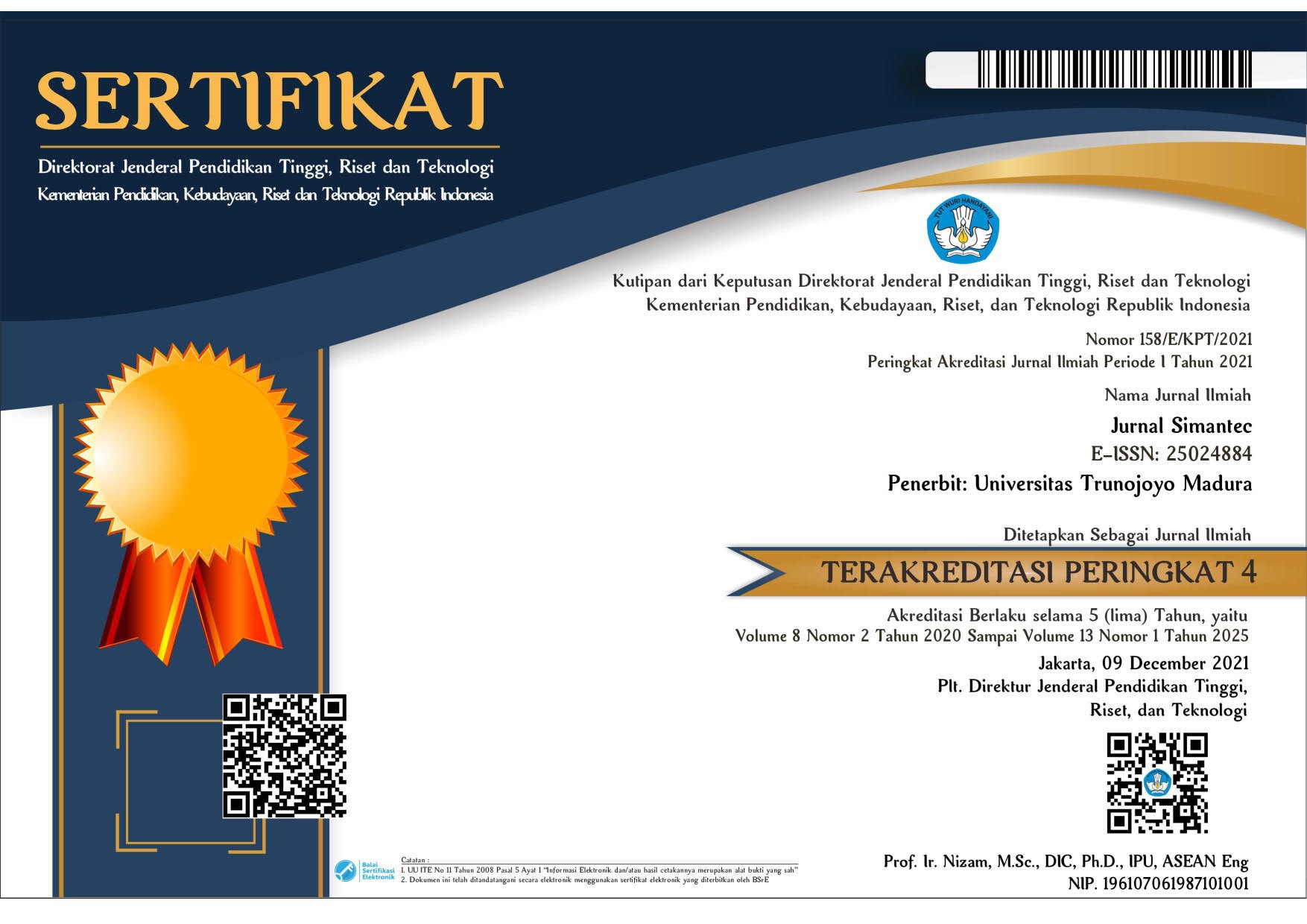Implementation of Least Significant Bit Steganography with Caesar Cipher Layout Dvorak web-based
Abstract
Secure data communication is an essential requirement in the digital age, especially in the exchange of confidential information. One of the main problems is the potential for eavesdropping by unauthorised parties who can access open messages. To overcome this, this research aims to develop a website-based system that combines the Least Significant Bit (LSB) method steganography technique and the Caesar cipher method cryptography with the Dvorak keyboard layout to increase data security. The research method used is prototype method with the stages of concept formulation, prototype design, and continuous evaluation. The system was tested by inserting the word ‘TEKKOM’ into a digital image and measuring the quality using Mean Squared Error (MSE) and Peak Signal-to-Noise Ratio (PSNR). The test results show an MSE value of 0.0001466049 and PSNR of 86.47 dB, which means that the visual quality of the image does not decrease significantly and the message is successfully inserted and extracted without errors. The Dvorak keyboard layout adds a layer of security through uncommon input patterns, making it difficult for outsiders to analyse. Thus, the system is able to provide a secure, efficient, and practical solution for web-based information hiding without the need for a database and is still user-friendly.
Keywords: Dvorak, Steganography, Caesar Cipher, Least Significant Bit, Website
Full Text:
PDFReferences
A. R. Putri, “Image processing using a webcam on a moving vehicle on the highway,” JIPI (Jurnal Ilmiah Penelitian dan Pembelajaran Informatika)., vol. 1, no. 1, pp. 1–6, 2016. [Online]. Available: https://doi.org/10.29100/jipi.v1i01.18.
S. Siaulhak, S. Kasma, and Suparman, “File delivery system using digital image processing steganography based on laboratory matrix,” Bandwidth: J. Inform. dan Rekayasa Komputer., vol. 1, no. 2, pp. 75–81, 2023. [Online]. Doi: https://doi.org/10.53769/bandwidth.v1i2.522
A. S. Joel, F. Abdussalaam, and Y. Yunengsih, “Medical record management based on information technology in handling patient data confidentiality and security using cryptographic methods,” J. Indones. Manajemen Inform. dan Komunikasi., vol. 4, no. 3, pp. 837–848, 2023. Doi: https://doi.org/10.35870/jimik.v4i3.287
S. D. Sari, “Privacy and data security in official statistics: challenges and solutions in protecting individual data,” Madani: J. Ilmiah Multidisiplin., vol. 1, no. 11, pp. 700–703, 2023. [Online]. Available: https://doi.org/10.5281/zenodo.10371661
A. L. Maryanto, M. N. Al Azam, and A. Nugroho, “Evaluation of information security management in technology-based startup companies using the KAMI Index.,” J. Simantec, vol. 11, no. 1, pp. 1–12, 2022. Doi: https://doi.org/10.21107/simantec.v11i1.14099
B. Anwar, N. B. Nugroho, J. Prayudha, and Azanuddin, “Implementation of the RSA algorithm for data security in savings and loan systems,” Sains dan Komputer (SAINTIKOM)., vol. 18, no. 1, pp. 30–34, 2019. [Online]. Available: https://doi.org/10.53513/jis.v18i1.100.
S. Magdy, S. Youssef, K. M. Fathalla, and S. ElShehaby, “DeepSteg: Integerating new paradigms of cascaded deep video steganography for securing digital data,” Alexandria Eng. J., vol. 116, pp. 483-501, 2025, doi: https://doi.org/10.1016/j.aej.2024.12.034.
L. F. Adhimah, I. Nurhafiyah, A. A. Muntahar, F. Kristiaji, and D. Mustofa, “Implementation of a web-based steganography application using the LSB and BPCS algorithms,” KOMPUTA: J. Ilmiah Komputer dan Informatika., vol. 12, no. 2, pp. 100–108, 2023. Doi: https://doi.org/10.34010/komputa.v12i2.10319
D. Pradeka, A. Adiwilaga, D. A. R. Agustini, A. Suheryadi, and R. Nuriman, “Design and build an assessment platform by inserting Moodle-based cryptographic methods,” TEKNOSI., vol. 9, no. 3, pp. 264–270, Jan. 2024. Doi: https://doi.org/10.25077/TEKNOSI.v9i3.2023.264-270
S. Solera-Cotanilla, M. Álvarez-Campana, C. Sánchez-Zas, and M. Vega-Barbas, “Proposal for a security and privacy enhancement system for private smart environments,” Internet of Things, vol. 31, p. 101585, 2025, doi: https://doi.org/10.1016/j.iot.2025.101585
I. U. W. Mulyono, Y. Kusumawati, and N. K. Ningrum, “Visual analysis of images resulting from the combination of steganography and cryptography based on the Least Significant Bit in cipher,” J. Masyarakat Informatika., vol. 14, no. 1, pp. 16–28, 2023. [Online]. Doi: https://doi.org/10.14710/jmasif.14.1.51484
A. Supardi, A. A. Alkodri, and B. Isnanto, “Steganography technique for hiding secret text messages in digital images using the Least Significant Bit method,” J. Sisfotek Global., vol. 11, no. 1, pp. 70–74, 2021. [Online]. Doi: https://doi.org/10.38101/sisfotek.v11i1.351
A. R. Mido and E. I. H. Ujianto, “Analysis of the impact of images on the combination of RSA cryptography and LSB steganography,” JTIIK., vol. 9, no. 2, pp. 279–286, 2022. Doi: http://dx.doi.org/10.25126/jtiik.201743299.
A. M. Ramadhani and T. Hassanuddin, “Modification of Least Significant Bits in images for data hiding in steganography,” IJODAS., vol. 2, no. 2, pp. 91–102, 2021. Doi: https://doi.org/10.25126/jtiik.201743299
A. Alenizi, M. S. Mohammadi, A. A. Al-Hajji, and A. S. Ansari, “A Review of Image Steganography Based on Multiple Hashing Algorithm,” Comput. Mater. Contin., vol. 80, no. 2, pp. 2463-2494, 2024, Doi: https://doi.org/10.32604/cmc.2024.051826.
Y. D. Cahyono, A. Suryanta, and I. P. Wardani, “Implementation of AJAX for a Dynamic Interface in a Website Builder with Hidden Message Embedding Capability,” JATI., vol. 9, no. 1, pp. 9–14, 2023. Doi: https://doi.org/10.36040/jati.v9i1.12129
G. M. Fahmi, K. N. Isanini, and D. Suhartono, “Image Steganography Implementation Using the Generative Adversarial Network (GAN) Algorithm,” SINTECH J., vol. 6, no. 1, pp. 47–57, 2023. Doi: https://doi.org/10.31598/sintechjournal.v6i1.1258
G. Zhao, Y. Huang, B. Jia, J. Ji, and P. Cheng, “A prototype low-pressure assisted microwave plasma ionization mass spectrometry for on-line monitoring of organic and inorganic hazardous compounds simultaneously: Design and feasibility validation,” Anal. Chim. Acta, vol. 1354, p. 344004, 2025, doi: https://doi.org/10.1016/j.aca.2025.344004
GeeksforGeeks, “Caesar cipher in cryptography,” GeeksforGeeks., [Online]. Available: https://www.geeksforgeeks.org/caesar-cipher-in-cryptography/. [Accessed: 9-Jan-2025].
B. Purnama and A. H. H. Rohayani, “A New Modified Caesar Cipher Cryptography Method with LegibleCiphertext From a Message to Be Encrypted,” Procedia Comput. Sci., vol. 59, pp. 195-204, 2015, Doi: https://doi.org/10.1016/j.procs.2015.07.552
DOI: https://doi.org/10.21107/simantec.v14i1.28794
Refbacks
- There are currently no refbacks.
Copyright (c) 2025 Ridhwan Nadif Kurnia, Muhammad Fajar Jati Permana, Al Diras Pradiptha, Rizki Afrizal, Kimberly Alfa Dipradja, Deden Pradeka, Zahra Khaerunnisa
Indexed By
.png)

11.png)













